Menus
- Carlos Checa’s 2011 World Champion Superbike
- 1.198 cc V-Twin, 199 hp, 165 kg, 319 km / h
- Genesis
- In the saddle
- Test
- Conclusion
Carlos Checa’s 2011 World Champion Superbike
1.198 cc V-Twin, 199 hp, 165 kg, 319 km / h
As unlikely as it may seem on the eve of the 2021 season and despite its previous domination in the category, this year marks the tenth anniversary of Ducati’s last coronation in the Superbike World Championship.. It’s true, the last of 14 drivers ‘world crowns and the last of the Italian brand’s 17 constructors’ titles were won exactly ten years ago, in 2011, thanks to Carlos Checa riding the team’s racing version. Althea’s private road sportswoman 1098R. This marks another historic landmark in WorldSBK as it is also the last time a private team won the championship, but also the last title for a twin-cylinder motorcycle. Scott Redding and his new Ducati factory teammate Michael Ruben Rinaldi have some work to do to end this series on their Panigale V4 Rs.
Yet 10 years ago, it wasn’t so much that Carlos Checa won his first World Championship at the age of 38, or even that he won the title three races to go after finishing. dominated the season with 15 wins in 24 races which made the Spaniard’s feat so remarkable. It’s mostly the bike he did it with and the circumstances in which he made it..
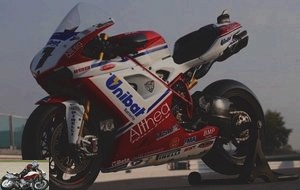 Team Althea Ducati 1098R RS11 review
Team Althea Ducati 1098R RS11 review
Genesis
Because when the 2011 WSBK Championship kicked off at Phillip Island in February, there was a major title contender missing on the starting grid. After having endured a bad year 2010, being beaten for the first time by an Italian rival brand with Max Biaggi on the Aprilia RVS4, the Bologna manufacturer was no longer officially involved in the competition. A first in 24 years since Marco Lucchinelli won the very first round of WSBK at Donington Park in 1988 on the desmoquattro 851. The decision of Ducati management to withdraw its factory team had aroused much criticism and could then be considered a lot. as the consequence of the defeat against Aprilia and the growing gap between the twins and the 4 cylinders. But in reality, the reason for Ducati’s withdrawal lies in the war that was then brewing between the Spanish promoters of MotoGP, Dorna de Carmelo Ezpeleta and the rights holders of the WSBK in Italy, Infront Motor Sports of the Flammini brothers..
 It is this 1098R which represents the last world crown of the manufacturer in WSBK
It is this 1098R which represents the last world crown of the manufacturer in WSBK
In 2008, Ducati became a private company, 100% owned by Performance Motorcycles, managed by the investment fund Investindustrial Holdings (IH). The manufacturer was then controlled by the Italian Bonomi family, with an office in Barcelona near the Dorna headquarters. But IH, above all, there was Carlo Campanini Bonomi, 70 years old, the only member of the family to sit on the Ducati board of directors. And with good reason, because he had been a big name in Italian financial circles for the previous 40 years. Thanks to IH’s investments in Spain, the Bonomis have become personal friends of Carmelo Ezpeleta. According to multiple sources, as friends of Dorna’s boss, the Bonomis have developed a growing disdain for Ducati’s involvement in WorldSBK, believing that the so-called two-wheeled Ferrari shouldn’t be concerned with what the one of them would have called "the World Championship of the poor". Instead, they felt that Ducati should instead focus exclusively on what was for them the most prestigious series, MotoGP, thus helping their companion Carmelo in his battle with the Flamminis. So this is what they did, ending Ducati’s official involvement in the 2011 championship, thus losing € 2.2 million of the funding already agreed with his sponsor Xerox, while encouraging Valentino Rossi to sign a two-year contract to drive his Desmosedici GP in 2011 and 2012.
 Checa and Bevilacqua surrounded by the mechanics of Team Althea
Checa and Bevilacqua surrounded by the mechanics of Team Althea
This meant entrusting the Team Althea of the wealthy Italian sportsman Genesio Bevilacqua, then the main private Ducati team, the task of representing the brand using the RS11 compe-clients already planned, with the support of Ducati engineers. The fact that everything worked out so positively, with veteran Carlos Checa, allowed the Bonomi’s strategy to unfold as planned. CQFD !
The chance to drive the future world champion machine in Misano at the start of September, as Carlos Checa prepared for his final acceleration to the title, gave me the opportunity to assess how he and the men of the Althea squad had arrived. Finally, with just a little help from Ducati, a multitude of engineers who were constantly present at every race. Despite this, the boss of Ducati Superbike, Ernesto Marinelli, insisted that Checa’s victory had been gleaned with a motorcycle that anyone could buy for 135,000 euros, the price of a customer RS11, as was indeed that of the defending champion.
 Although derived from the stock 1098R, the RS11 has some size differences
Although derived from the stock 1098R, the RS11 has some size differences
For 2011, following the shutdown of the factory Superbike team, we sold the four F10 motorcycles from Haga and Fabrizio to Team Liberty and built a handful of new compe-customers, two of which went to Althea for Checa. These had improved Marelli ECU software with revised mappings, a new camshaft design with a different profile giving an extra 2/3 hp, new lightweight Brembo front monoblock calipers, a new Ohlins TRVP25 fork. Everything else on the bike was unchanged from the previous season, but the huge attention to detail Carlos invested and his talent on the track made the difference..
 Brembo monobloc calipers have nothing to do with the components of the production model
Brembo monobloc calipers have nothing to do with the components of the production model
This included the vast top speed differential between the desmo V-Twin and its 4-cylinder rivals, as demonstrated by Checa’s top speed of 319 km / h reached at Monza in May, far behind 333 km / h. h of the RSV4 factory of Biaggi and Camier. This chasm in performance puts Checa’s success in winning so many races into perspective and not necessarily on slow tracks where handling takes precedence over engine performance..
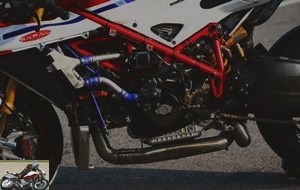 The 1.198 cc L-Twin delivers 199 horsepower here
The 1.198 cc L-Twin delivers 199 horsepower here
In the saddle
In the hands of Carlos Checas, the 1098R RS11 continued to perform. Just getting on board your Ducati at Misano immediately revealed one of the reasons why this was the case, as the riding position seemed very balanced, rational, much less tiring compared to the more extreme positions I had. could experiment on other Ducati Factory. The saddle is relatively spacious and allows to move behind the large 23.9 liter tank allowing it to finish a Superbike race compared to the stock 15.5 liters.
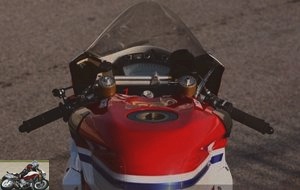 The 1098R leaves enough room on board to lie behind the small bubble
The 1098R leaves enough room on board to lie behind the small bubble
As always on a Ducati with its fairly long wheelbase of 1,435 mm due to the L-shaped architecture of the engine, enough space is left to move forward and load the front wheel with its weight in the bends, then to move back to wedge behind the narrow bubble in the straights of Misano, without any instability of the front, thanks to a caster angle of 24.5 ° and to the rather classic slopes that Carlos varied from one circuit to another in playing on the offset. This rational chassis geometry has one flaw, however: it is the extra physical effort required to take the Ducati from one angle to another in a series of slow turns, like the first tight sequence at Misano, especially compared to with more lively four legs, especially the Aprilia which can be carried almost as easily as a 250.
 The long wheelbase of the Ducati translates into good handling, but also less liveliness
The long wheelbase of the Ducati translates into good handling, but also less liveliness
It has always been a downside to Ducati architecture. And that’s what Carlos told me he first noticed when he made his debut on the Desmo in Portimao in October 2009..
Test
However, this marvelous torquey engine with its characteristic, quirky exhaust note more than makes up for this deficiency. And driving the world champion Checa on a track like Misano with so many slow corners underlines the advantages of the twin in terms of handling and forgiveness. The bike forgives mistakes (and I’ve made a lot of them!) In a way that Melandri’s faster and more demanding Yamaha YZF-R1 never would. This makes the Ducati a potential excellent bike in traffic, where you can hold gear, change course or wrap your wrist for extra thrust to gain position when needed. Do this with the Yamaha and you just missed the chord point and you start to pull wide, wasting precious time in the maneuver..
 The 1098R forgives a lot of pilot errors
The 1098R forgives a lot of pilot errors
I immediately noticed that Checa was using a very long first gear on the Ducati’s six-speed gearbox. He had also adapted the bike to use only the 5 lower gears for the Misano track. "I tried to use only 4, but 5 is better!" he told me, revealing that he used the lower gear four times per lap. "I put it on first to get more engine braking and to maintain a tight trajectory in tight bends, but also because when you open the throttle the response is more direct, the second is too long with too low revs. ". Checa also installed the adjustable slip clutch to have more engine braking than other Ducatis and he used it to assist the bike in braking, letting it dampen rear wheel movements by tapping the clutch lever on the engine. finger, the Ducati is just great on braking.
By using the lower gear while harnessing the power provided by the RS11’s Brembo radial package, you gain stopping power and control when you reach the chord point, as long as you don’t forget to play. of the clutch to avoid dribbling. It also allows for a tighter turn as in the turn leading to Misano’s main straight, where maintaining a tight line before straightening up faster allows for the throttle to be opened much sooner..
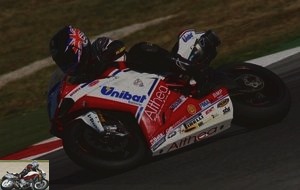 Engine braking is important, so remember to use the clutch to avoid dribbling from the back.
Engine braking is important, so remember to use the clutch to avoid dribbling from the back.
I had an excellent demonstration of the Ducati’s strong recovery coming out of the final second corner towards the pit straight, when Marco Melandri made me inside under braking and his teammate Eugene Laverty tried to push me through. do it outside. I’m not inventing, it was a Yamaha test day in which the best teams participated. However, once more or less straightened, I was able to open wide as easily as a former 250 GP World Champion and propel the Ducati in pursuit of Marco. I then noticed how well it accelerates from low revs in second gear around 7,500 rpm, lifting the front wheel up in second then third before pressing the rear brake each time to keep it there. on the ground, before finally losing it on 4th as the revs climbed. But although Marco was too fast, I managed to keep pace with Eugene along the straight in 4th, seeing the guys from Team Althea on the pit lane wall cheering me on with raised arms! Sorry, guys, not brave enough: Eugene passed me in turn two, immediately followed by Jonathan Rea in the Castrol Honda. But I had a good illustration of the performance of the V-twin engine compared to the four cylinders and it is obvious that Carlos won his world title by driving intelligently and compensating for the power deficiencies of the Ducati with late braking and a quicker entry into bends. Oh and make your Pirelli tires last longer too…
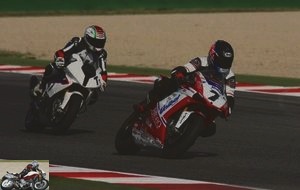 Many official drivers were present during this test, in particular Toni Elias on the BMW S1000RR
Many official drivers were present during this test, in particular Toni Elias on the BMW S1000RR
Although the Ducati picks up from 5,000 laps at the exit of a slow corner, you have to wait for the odometer to display 7,000 laps to achieve serious acceleration. But by pushing it beyond, the Ducati then comes out with an impressive acceleration, until the three green lights of the clutch lever above the dashboard start to flash at 11,800 revolutions and it is necessary to pass. to the upper gear. There is also a red light, bigger, installed on the right, but Carlos had not connected it, I discovered it by triggering the breaker at 12,400 turns.
I found the racing gearbox a bit "sticky" in downshifts and it took a lot of foot pressure to change gears in both directions. Also, I still had to use the clutch to downshift which, after two sessions on four-cylinder Superbikes equipped with shifter, meant I had to reconnect my brain for this manipulation. Fortunately with the slip clutch, no need to close the throttle while going down in the gearbox of the Ducati…
 The gear change lacks fluidity on the 1098R RS11
The gear change lacks fluidity on the 1098R RS11
The reduced weight transfer and more rational steering geometry of Checa’s chassis give the Ducati 1098R a confident feel on the brakes, aided by the additional engine braking of the slip clutch. So we still have the traditional feeling of a desmo V twin that stops hard.
On the other end of the turn, the traction control feels really stealthy, but must work, as I didn’t unhook the rear wheel even when following the factory Yamaha’s. I just heard from time to time a slight thumping of the engine at the exit of a curve, but without this affecting the resumption of the engine. The throttle by wire accelerator has a smooth and smooth response, providing strong acceleration. All the electronics seem really accommodating and give enough confidence to open on the angle, without feeling the need to straighten the bike before daring to accelerate hard, as when coming out of the last on the second. I could then go harder on the throttle, earlier, knowing that I wasn’t going to lose the backside doing so. Accomplished job.
 Hardly noticeable in driving, the on-board electronics play its role perfectly
Hardly noticeable in driving, the on-board electronics play its role perfectly
Conclusion
Ducati must send a big thank you to Señgold Checa, as well as Team owner Althea Genesio Bvilacqua and his team of mechanics for making the Italian company’s controversial strategy of removing its factory Superbike team in 2011 work while giving the car a second life. aging 1098R.
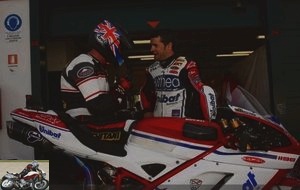 Carlos Checa providing sound advice on riding his motorcycle
Carlos Checa providing sound advice on riding his motorcycle
In addition to winning the WorldSBK crown and constructor title, Althea added the icing on the cake by taking young Romain Davide Giugliano, then 22, to the Superstock 1000 World Champion title that same year, again with the 1098R. Genesio and Team Althea not only put Ducati back on top of the two categories derived from production motorcycles, but by winning the manufacturer’s 14th WSBK title, Carlos Checa also helped spare Ducati’s redness by offsetting the embarrassment of his very publicized, but ultimately disastrous, MotoGP campaign with Valentino Rossi…
Strong points
- Engine recovery
- Braking
- Maneuverability
- Electronic
Weak points
- Top speed
- Less lively than the 4 cylinders
- Hard clutch
The technical sheet of the Ducati 1098R RS11
Related articles
-
Ducati 350 SCD motorcycle test
From the circuit to the road for the Italian sportswoman 4-stroke single cylinder, 340 cc, 42 hp, 210 km / h, 112 kg dry In 1954, the arrival of Fabio…
-
Always so surprising L-Twin Testastretta DVT, 1262 cm3, 159 hp, 129 Nm (13.1 mkg), 244 kg full made, 17 liter tank, € 20,490 and € 23,490 in S version…
-
For a few more horses Ducati overhauls its Hypermotard by giving it a little more boot with the 939 version. We were able to discover two of the three…
-
Fine-tuning in order You don’t change a recipe that works. The second generation of the Ducati Diavel therefore evolves only on points of detail while…
-
V2, 821 cm3, 109 hp at 9,250 rpm, 86 Nm at 7,750 rpm, 180 kilos dry, from 11,450 € Ducati’s mid-size roadster is getting a makeover and fine-tuning the…
-
A power cruiser with Italian sauce. Punch, style, noise, character ! V2 1262 cm3, 152 hp at 9,500 rpm, 12.8 m / kg at 5,000 rpm, 220 kilos dry, from…
-
The best, quite simply 998 cc V4, 221 hp (234 hp) and 112 Nm, electronics and ride-by-wire, aerodynamic fairing, 193 kg full facts, 39,900 euros 2019…
-
THE Successful Monster Ducati has been offering its successful roadster since 1992. The R versions symbolize the maximum sportiness of these machines. We…
-
Ducati Panigale V2 motorcycle test
Mini-V4, maxi-pleasure? Controlled origin flavor V-twin Superquadro 955 cm3, Euro5, 155 hp and 104 Nm, 176 kg dry, 18,290 euros Family culture obliges,…
-
Ducati Multistrada V4 S motorcycle test
La dolce-veloce vita V4 Granturismo of 1.158 cm3, 170 hp and 125 Nm, 243 kg, radars, semi-active suspensions, from 19.590 €… It’s been almost twenty…
The Z 750 is heavy and clumsier than its rivals, even in R.
It is a good machine but the new ones are superior to it in agility and engine pleasure..
Its aesthetics please but facing a GSR or a 675 Street … it is less easy, less efficient.
However its finish is very correct in R.